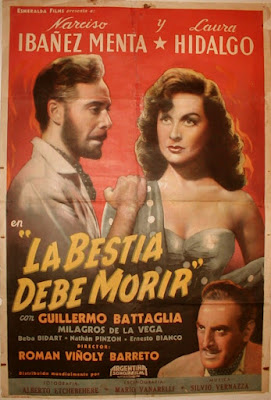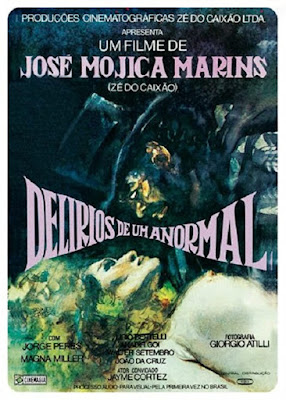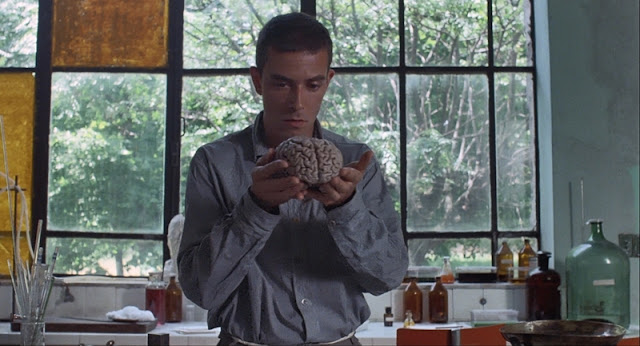The Aerial (aka: La Antena) (2007) If Guy Maddin took a wrong turn in Winnipeg and ended up in Buenos Aires, he might have concocted something like this. Writer/director Esteban Sapir’s whimsically dark fantasy recalls the style of the Canadian director, but has an energy all its own. The predominately silent black-and-white film, takes place (appropriately enough) in a city that’s lost its voice. A faceless singer and her eyeless son (who inherited her vocal gift) are stalked by a ruthless millionaire, who wants to exploit them for his own devious ends. It’s up to a lowly TV repairman and his estranged wife to save the day. The Aerial may not be the easiest movie to find, but worth seeking out.
Rating: ****.
Available on DVD (Region 2)
The Beast Must Die (1952) Not to be confused with the 1974 Amicus movie carrying the same name, this delectable slice of Argentine noir from director/co-writer Román Viñoly Barreto captivates from start to finish. Felix Lane (Narciso Ibáñez Menta), a writer of murder mysteries, plots a murder of his own when his son is struck and killed by a hit-and-run driver. He befriends a glamorous actress (Laura Hidalgo), who could be his only link to the driver, Jorge Rattery. Guillermo Battaglia is excellent in the role of unscrupulous (and aptly named) businessman Rattery, one of the most despicable characters in noir. The story, told mostly in flashback, illustrates how everyone around Jorge wanted him dead. It’s an emotionally devastating, beautifully acted, meditation on the weight of loss.
Rating: ****.
Available on Blu-ray and DVD
The Wolf House (aka: La Casa Lobo) (2018) This visually inventive, profoundly unsettling Chilean film by co-directors Joaquín Cociña and Cristóbal León employs a variety of animation techniques to tell its melancholy tale, steeped in metaphor and mythology. After fleeing a religious cult, Maria tries to make a home for herself, with two pigs in tow. The nightmarish images are purposely rough around the edges, adding to the tumultuous feel, making no attempt to hide the artifice of the animation. It’s a soul-wrenching portrait of abuse, and the terrible cycle that perpetuates.
Rating: ****.
Available on DVD, Kanopy, Shudder and Tubi
Bacurau (2019) The tiny village of Bacurau suddenly falls off the map, leaving the residents vulnerable to the sick machinations of a corrupt local politician and a group of bloodthirsty mercenaries (led by Udo Kier). The film starts with a mystery, as people are prevented from entering or leaving the town. As secrets are slowly revealed, the mystery gives way to a standard revenge flick, with shades of The Most Dangerous Game. Even if it falls somewhat short, Bacurau features some excellent performances by Kier and Sonia Braga (who plays one of the village elders), and an interesting depiction of rural Brazilian life, making this well worth your time.
Rating: ***½.
Available on Blu-ray, DVD and Kanopy
Dona Flor and Her Two Husbands (1976) Sonia Braga stars as the title character, married to two-timing ne’er do well Valdomiro (José Wilker). When Valdomiro unexpectedly expires, due to another round of debauchery, Dona Flor is on the lookout for new husband material. She eventually settles for mild-mannered pharmacist Teodoro (Mauro Mendonça), and his promise of domestic stability. But a trivial thing like death doesn’t end things for her first husband (who’s only visible to her), who frequently returns for some amorous attention. Now, Dona must reconcile her mixed feelings for Valdomiro’s lecherous ways and Teodoro’s kind but dull personality. It’s well-acted, albeit a trifle overlong, and one has to question the dated premise that Dona has to choose at all between two less-than-stellar prospects.
Rating: ***. Available on Blu-ray, DVD and Kanopy
Hellish Flesh (aka: Inferno Carnal) (1977) Brazilian shock pioneer José Mojica Marins (who also wrote and directed) stars as Dr. George Medeiros, a scientist (studying what, I couldn’t tell you) and doting husband. Unfortunately for Medeiros, he doesn’t realize that his wife Raquel (Luely Figueiró) has been sleeping with his friend Oliver (Oswaldo De Souza). The two lovers scheme to get rid of Medeiros by throwing acid (which has been conveniently sitting in an open flask above his work desk) in his face, followed by a laboratory fire. Naturally, Medeiros’ disfigurement doesn’t stop him from plotting his revenge. It’s cheaply made, with a twist that isn’t much of a twist, and there’s nothing particularly original about the plot, but it’s marginally diverting.
Rating: **½.
Available on DVD (Out of Print)
Los Decentes (aka: A Decent Woman) (2016) Belen (Iride Mockert), a repressed 32-year-old woman takes a job as a live-in maid at an exclusive gated community. She soon discovers just beyond the immaculately trimmed hedges and rolling golf course, lies a nudist colony. One day, she decides to throw caution (and her clothes) to the wind and join them, finding a new-found freedom in her covert lifestyle. The first two-thirds provide an interesting, subtle satire on a clash of cultures and values, with ample commentary on the haves and have nots. Unfortunately, it disintegrates in the third act, with a surprise (and tasteless) twist that undermines the rest of the film. Close, but no cigar.
Rating: **½.
Available on DVD and Kanopy
Hallucinations of a Deranged Mind (1978) Writer/director José Mojica Marins, working with next to no budget, cobbled together this half-baked horror film, with a surprisingly unique premise. A psychologist goes off the deep end, hallucinating that he’s being tormented by Coffin Joe His colleagues try to bring him out of his trance, bringing in the actor who played Coffin Joe (Marins as himself) in an attempt to bring him out of his trance. The interesting meta theme pre-dates Wes Craven’s A New Nightmare by several years. Unfortunately, it’s padded out with multiple scenes from previous Coffin Joe movies. The seemingly endless repetition of the same shots makes this one a chore to watch. For Coffin Joe completists, only.
Rating: **.
Available on DVD















